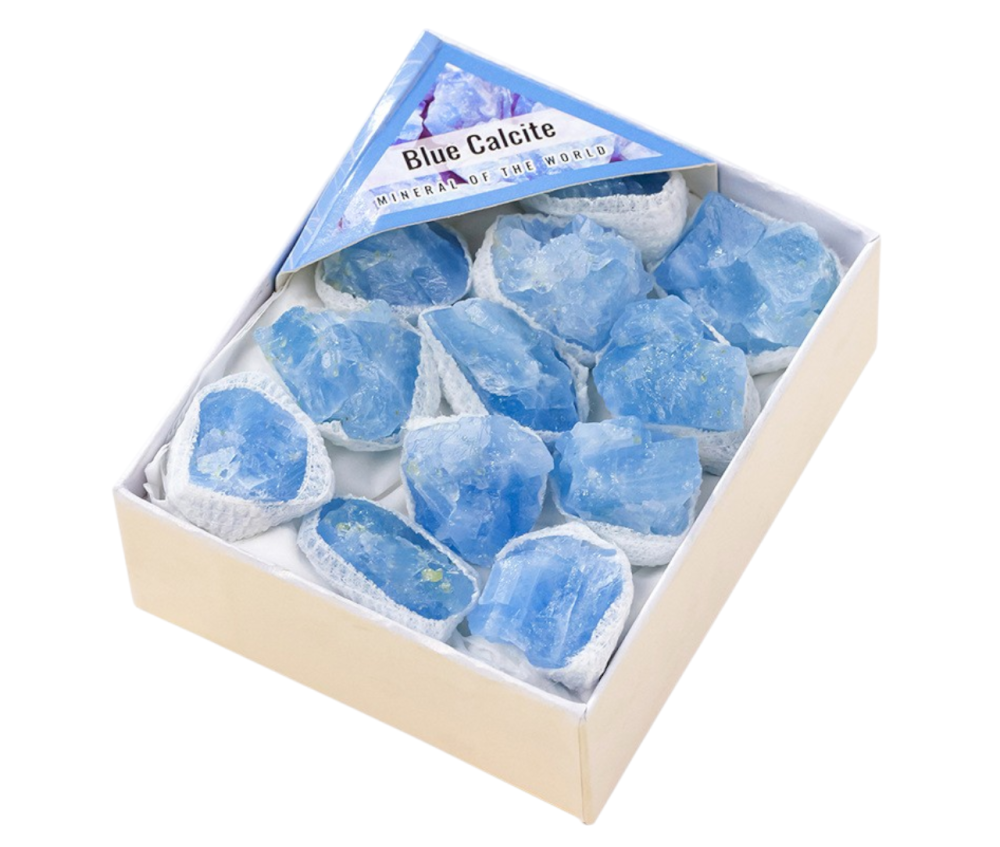We use cookies to make your experience better.
TimmersGems has a new website, existing customers also need to register again.
Assortment box with blue calcite (9 pieces) For on the counter.
Beautifully sorted assortment in a stunning display box that looks magnificent on the counter. Especially eye-catching for children who always look at the minerals from our nature with wonder.
Availability:
In stock
SKU
121961
The mineral calcite (also known as calc-spar) mainly consists of the salt calcium carbonate (CaCO3) and is one of the most common minerals in the Earth's crust. Calcium carbonate is formed when soluble calcium ions come into contact with carbon dioxide, forming a carbonate ion when a positive ion is present in a solution. Calcium carbonate is a poorly soluble salt, causing the formed CaCO3 to precipitate; this occurs according to the following reaction: Ca²⁺(aq) + CO₃²⁻(aq) → CaCO₃(s). Calcite has a trigonal crystal system and belongs to the space group R-3c. A very pure form of calcite is also called Iceland spar due to the double refraction of light in this mineral. It has a rhombohedral structure and is sometimes found as rhombohedral prisms, but it also often occurs in other forms, such as scalenohedra, or in fibrous, granular, or compact form. The crystal structure is mainly a result of the temperature, the degree of supersaturation in the immediate vicinity of the crystal, and the CO₂ pressure. The calcite structure is the stable modification of CaCO₃ at room temperature. There is another form, aragonite, which transitions into calcite at 743K. In pure crystalline form, calcite is clear, colorless, and translucent, but due to impurities (such as copper or sodium salts), it can take on various colors, such as gray, blue, violet, green, and even black. Often it is also opaque white. The mineral can exhibit both phosphorescence and fluorescence. The hardness is by definition 3. Calcite is strongly birefringent. This optical property was first described by Rasmus Bartholin when the Icelandic form of the mineral, which consists of large glass-clear rhombohedra, became available. Christiaan Huygens provided the first explanation with his wave theory of light. Calcite is a common component of sedimentary rocks, veins, and deposits in hot springs and caves in karst areas (as stalactites). It is the mineral that forms limestone and thus the most common mineral of biological origin. Calcite is the main component of limestone, chalk, and marble, and it is also an important component of marl, calcareous sandstone, and limestone shales. Calcite is responsible for chemical weathering in igneous and metamorphic rocks, leading to the formation of sedimentary rocks. Calcite is soluble in CO₂-containing water under light pressure. During its descent through the air, rainwater absorbs gaseous carbon dioxide, making it acidic. This acidic rainwater is capable of dissolving limestone. In underground streams, this material can be transported in solution until, upon contact with atmospheric pressure, CO₂ escapes and calcite precipitates. This is how stalagmites and stalactites are formed in caves.
| Dimensions | One Size |
|---|---|
| Country of Manufacture | China |












